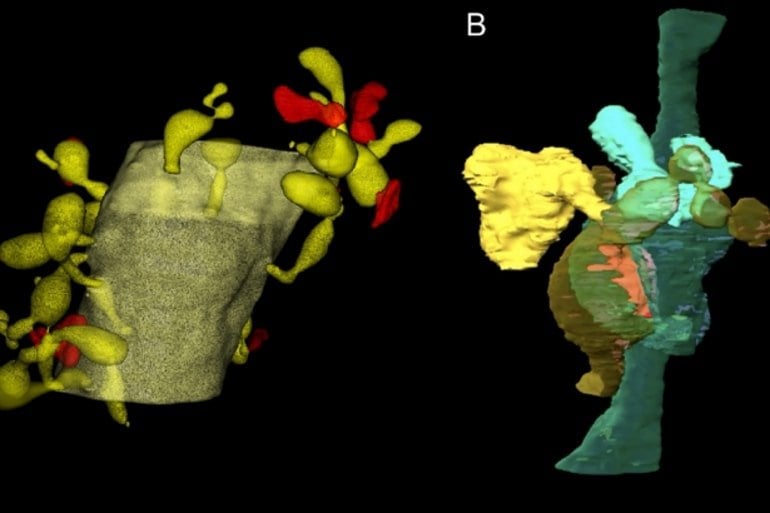Summary: Bergmann glial cell synaptic engulfing within the cerebellum was enhanced throughout motor studying in mice.
Source: Tohoku University
Tohoku University researchers have proven that Bergmann glial cells, astrocyte-like cells within the cerebellum, ‘eat’ their neighboring neuronal components inside wholesome dwelling mind tissue.
Synapses – buildings that enable neurons to cross indicators to 1 one other – are repeatedly pruned all through a mind’s improvement to enhance its effectivity. Disruption of that is thought to result in numerous mind issues.
The researchers’ findings, which have been detailed within the journal Nature Neuroscience, found that Bergmann glial engulfing of synapses was enhanced throughout motor studying in mice’s cerebellum, an essential mind area for studying.
Moreover, pharmacological blocking this engulfment inhibited synaptic structural adjustments, leading to a part of the training and reminiscence course of being misplaced.
Glial cells, non-neuronal cells occupying about half of the mind, have been beforehand believed to be like glue – merely filling the hole between neurons. However, latest findings present that glia encode data in their very own distinctive manner.
“Glia are, of course, not another subcategory of neurons,” says Professor Ko Matsui of Tohoku University’s Super-network Brain Physiology lab, who led the analysis. “We have yet to uncover the glial impact on information processing.”
When cells engulf neighboring cells to flush out particles and pathogens, it’s referred to as phagocytosis. Phagocytosis by microglia, immune cells within the mind, in broken and diseased mind tissue has lengthy been acknowledged.
Recent reviews have established that astrocytes and microglia phagocytose neuronal components, together with synapses throughout early mind improvement or when dramatic neuronal community reworking happens within the diseased mind.
Tracing engulfed supplies is difficult in wholesome brains, because the lysosomes within the glia shortly degenerate the proteins.

Matsui and his staff turned to the degeneration-resistant fluorescent protein pHRed to alleviate this downside. Using high-resolution 3D electron microscopy, they captured the Bergmann glia nibbling on synapses elements and different neuronal elements in grownup wholesome mice brains.
Furthermore, glial phagocytosis was enhanced in mind tissues taken after cerebellar-dependent motor studying duties. When phagocytosis was pharmacologically blocked, a number of the studying was misplaced.
“Our finding provides a novel glial mechanism in synaptic plasticity linking learning and memory. It is possible that the phagocytic capacity of glia might be variable under the certain states of our mind and glia may play a pivotal role in meta-plasticity of memory formation,” mentioned Matsui.
Lead research investigator Dr Yosuke Morizawa says that their discoveries may have attainable implications for explaining why synaptic shrinkage and loss happen in melancholy, schizophrenia, and Alzheimer’s illness.
The staff’s subsequent step is to see if glial phagocytosis of synapses malfunctions in animal fashions of those illnesses.
“A therapeutic strategy designed to target glial phagocytosis might enhance memory and treat certain brain disorders,” added Matsui.
About this reminiscence and studying analysis information
Author: Press Office
Source: Tohoku University
Contact: Press Office – Tohoku University
Image: The picture is credited to Morizawa & Matsui
Original Research: Closed entry.
“Synaptic pruning through glial synapse engulfment during motor learning” by Ko Matsui et al. Nature Neuroscience
Abstract
Synaptic pruning by glial synapse engulfment throughout motor studying
Synaptic pruning is a elementary strategy of neuronal circuit refinement in studying and reminiscence. Accumulating proof means that glia participates in sculpting the neuronal circuits by synapse engulfment.
However, whether or not glial involvement in synaptic pruning has a task in reminiscence formation stays elusive.
Using newly developed phagocytosis reporter mice and three-dimensional ultrastructural characterization, we discovered that synaptic engulfment by cerebellar Bergmann glia (BG) ceaselessly occurred upon cerebellum-dependent motor studying in mice.
We noticed will increase in pre- and postsynaptic nibbling by BG together with a discount in backbone quantity after studying. Pharmacological blockade of engulfment with Annexin V inhibited each the backbone quantity discount and in a single day enchancment of motor adaptation.
These outcomes point out that BG contribute to the refinement of the mature cerebellar cortical circuit by synaptic engulfment throughout motor studying.














Discussion about this post